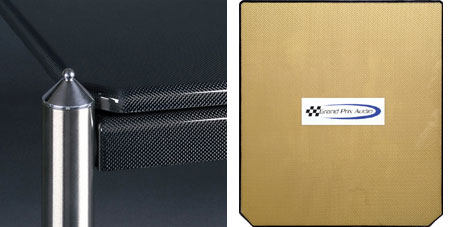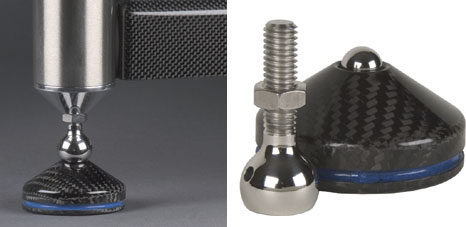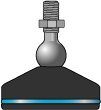
You are reading the older HTML site
Positive Feedback ISSUE
40november/december 2008
grand prix audio
Formula Shelf and Apex Footers
as reviewed by Greg Weaver

|
It has been nearly three years since I reviewed the superlative and, to these ears, unsurpassed, Grand Prix Audio Monaco Modular Isolation system. Since that time, I have gradually been able to improve upon its original spectacular effectiveness, one-step at a time.
The first improvement came when I was asked to review the Redpoint Model D turntable. Alvin Lloyd was kind enough to send me a Formula Shelf to evaluate in its roll supporting the 135-pound behemoth music maker from Peter Clark. Even though the three-quarters of an inch thick clear acrylic top shelf of my original system would have been adequate to support the weight of the Model D, it somehow seemed the appropriate opportunity to make the move to the cost-no-object, unique cellular structure and cross-linked resin system Formula shelf.

The distinctive core material used in the GPA Formula Shelf was developed originally for nuclear facilities, aerospace, and aviation isolation applications. The distinctive looking carbon fiber shell, combined with this proprietary core, exhibits a high strength to weight ratio, and provides substantial resistance to the transmission of vibration across a broad frequency range.
To stop at calling the GPA Formula Shelf merely effective would be like proclaiming the Arctic Circle can get "chilly" in winter. Replacing the clear acrylic top shelf under the Model D, the formula shelf's impact and contribution was more significant than I could have imagined, even given my previous experience with all things GPA. I was afforded even more space than previously, in all three dimensions, as well as more accurate sizing and more clearly defined localization of instruments. The original velvety black quietness became even quieter! The overall background calm established from which the music emanates was even darker with the formula shelf in place... I sent my check!
Interestingly, at the same time he had sent the Formula Shelf, he included a set of the Apex footers. Each of the three just under an inch and a half tall Apex footers is fabricated from two hand-laminated, high-pressure vacuum-cured layers of Carbon fiber. Those two layers, both the outer skin and the core/base of the device, are decoupled via a proprietary damping polymer.

The super-dense polymer (also used in the upright columns of their Monaco SE) separating the core/base segment of the Apex from its outer skin was developed in collaboration with one of their former racing aerospace partners. Alvin claims that it exhibits a far higher energy dissipation ratio than any of the metals or compounds commonly used for other component isolation footers, and is just one of many claimed technological advances Grand Prix Audio enjoys over its competition.
By presenting three dissimilar materials
boundaries to the energy pathway between the isolation systems floor and
column junction, and using materials without inherent grain or crystal
structures, the bi-directional flow of vibration is heavily attenuated
to measurably lower resonances and system noise floor. Alvin is only too
happy to point out that the same effect is observed when used as a shelf
to component isolation device when placed under a component, on a GPA,
or any other competing isolation, stand.
Finally, atop this high tech constrained layer structure is a ball
bearing, securely seated in a high-rim depression. The common diameter
(0.5") of the ball bearing employed with the Apex footer allows the end
user to experiment with a variety of bearing materials readily
available, including ceramic silicon nitrate, Tungsten carbide, or the
hard chrome set included in the base purchase price.
In my application, the three Apex footers took the place of the three stock threaded slender "points.' Now, a 3/8-16 thread, .875 diameter, 2-inch long leveler, or "knuckle," threads up into each of the three legs of the Monaco (or ANY of the GPA line), replacing the slender points. These knuckles rest securely on the ball bearing atop the Apex. A Monaco Isolation System resting on the Apex solution will acquire new freedom in two planes of motion (front to back and side to side), though no movement is noticeable to the naked eye.
As gorgeous as they look and as hopeful as I was, my initial listening left me less than overly impressed. Not that they were bad or anything, it was just that in that preliminary short audition, my initial impression was that they were just a bit better than the stock points. After just a few days, I removed them and went back to the original spikes.

Yet something about that listening test continued to trouble me, long after their removal. After several conversations with both Alvin Lloyd and audio pal Steve McCormack, and having had some time to reflect carefully upon that original evaluation, it became clear to me. At the time I made my initial cursory evaluation, I had violated my own third axiom, in development from the early 1970's, but finally codified in the winter of '99.
In the space of some two short weeks, a plethora of items had landed here at the audio analyst© for evaluation. During that fortnight, I was swapping out items in an attempt to settle on the best synergy of systems and components with which to evaluate the Redpoint Turntable. I was routinely exchanging the new turntable with the old, the Formula Shelf with the acrylic, had recently moved to new a pair of loudspeakers still under evaluation at that time, and was trying several different loudspeaker cable systems as well as the Apex footers. My initial impression of their efficacy was indubitably tainted by the constant parade of all the other items at that same time.
Oscar Wilde said, "Experience is simply the name we give to our mistakes." In that context, I have a LOT of experience. This time, after having made no significant changes to the system for some five months, I listened for the better part of an afternoon, status quo. Then I installed the Apex footers in place of the spikes, and made no other changes. My early evening's listening was MUCH enhanced.
MAN, how did I miss the significant leap forward in resolution, increase in "transparency," and overall "focusing" of the entire sonic picture the Apex footers clearly afforded? Deep bass, and I'm talkin' first-octave and below here, mid teens to 40 Hz, had taken on a newfound detail, honesty of timber or color, and a sensation of speed not unlike that I experienced when I first installed the Stealth Indra cables.
Besides having the above stirring "effect" on the bottom end, their introduction also contributed to MUCH more lifelike localization, sizing, and refined layering of instrument placement throughout the entire soundstage. They have further had the effect of "enhancing" the silence from which all sounds sitting on the Monaco now emanate… DAMN my records are quite now!
The broadband enrichment in pitch definition, i.e., the perceived fundamental frequencies of virtually all instruments, be they wooden, brass, reed, skin, or human, is remarkably more discernable and, therefore, realistic sounding… This imparts an overall "clarity" to the entire sonic tapestry, actually allowing it to be woven together more finely, while at the same time, augmenting the experience of being an organic, single musical entity… Their addition seems to allow a deeper, clearer, more intimate view back INTO the performance, liberating considerably more of the musical message. Hell, they even contribute to a slight "extension" of the uppermost frequencies. Once again, I sent my check with a HUGE thank you.
If I were to grant numerical values to the improvements these "upgrades" to the remarkable stock Grand Prix Audio Monaco Modular Isolation system contribute, then I would say that the Formula Shelf would effect a 12-15% enhancement to any components that rest on it. The Apex Footers afford something like 25 or 30% improvement to anything resting on any shelf of the Grand Prix Audio Monaco Modular Isolation system.
The Grand Prix Audio Apex Footer is an absolute NO-BRAINER and may be the single most effective isolation device I've yet had the good fortune to discover. I just received a set of Monaco Amplifier stands. It is my hope that I can talk Alvin Lloyd into allowing me to experiment with a couple more sets, perhaps under my speakers and/or the Amplifier stands. But, that will be another story… Greg Weaver
Specifications
Formula Shelf
Small (20.75" W x 17.75" D) $1100
Large (21.00" W x 23.30" D) $1100
X-Large (21.00" W x 27.00" D) $1250
Brooklands (23.50" W x 18.63" D) $1100
Specifications Apex Footers
Diameter: 2.5-inch
Height: 1.45-inch
Weight: 130 grams
Center of Gravity: ca. 1-inch above
base
Apex Carbon Composite Footers (includes 3 x 1/2" hard-chrome balls): $550.00/set of 3 Polished Stainless Steel Cup, Threaded Adjuster/Levelers: Starting at $180.00/set of 3Silicone Nitride, Upgrade Ball for Apex $42.00/set of 3
Grand Prix Audio
web address:
www.grandprixaudio.com

